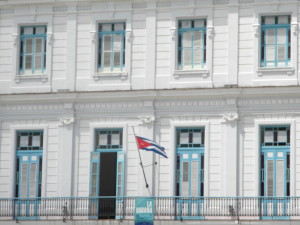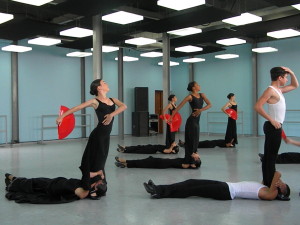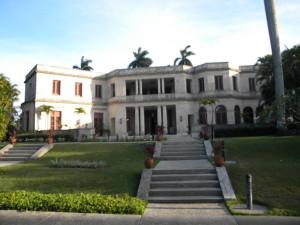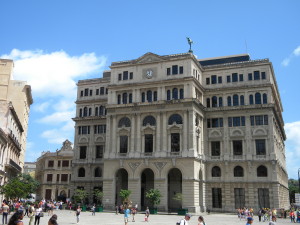Despite Cuba’s geographic proximity to the United States, historical circumstances have served to widen the distance between our two countries. As both nations begin to turn the page towards a future of greater closeness and cooperation, leaders from both sides of the straits are seeking ways to increase understanding and develop relationships between our countries.

In April of 2016, led by Ambassador Stuart Holliday, a distinguished group of members of Meridian International Center’s Board of Trustees and other supporters, undertook a trip to Cuba. Consistent with Meridian’s mission to “understand global issues and cultures, exchange ideas, collaborate on solutions, and build valuable relationships”, the delegation’s focus was not only to learn more about Cuba but also to begin to forge key cultural linkages between both countries.

Prior to the trip, not only was I was looking forward to expanding my knowledge of the island, but I was also excited about the opportunity to learn from and be a part of a delegation of global leaders known for strengthening U.S. engagement abroad. I also looked forward to once again spending time with my father on the island of his birth. As Chairman of Meridian, my father, former Secretary of Commerce Carlos Gutierrez, would also be joining the delegation. To top it off, my youngest sister Karina, would be accompanying the delegation on her first trip to the island.

Cuba’s history is long and rich. First discovered in the late 15th century, Cuba’s past as one of the earliest colonial settlements in the New World, its important position as a major trade route in the Caribbean, and the intermingling of various ethnicities and religions on the island have helped shape Cuba into the unique nation it is today. Our delegation was ecstatic to learn more about the country first-hand.
Upon landing in Havana, I was once again reminded why throughout history many have referred to the island as the “Pearl of the Antilles.” With its colonial era architecture, fleets of roaming antique vehicles, and crashing waves perfectly complimented by a magnificent blue sky, Havana is without a doubt a magical city. Yet, a city can only be judged by the total sum of its parts, with a city’s inhabitants playing a big role in helping to establish its character. It is here where Cuba most shines. Undoubtedly, the Cuban nation’s most important asset are its vibrant, welcoming, and talented people.
Throughout our stay we were welcomed, greeted and engaged by Cubans from all different sectors of society. On our first night we congregated at the house of internationally renowned Cuban artist Michel Mirabal, swayed to the soulful tunes of legendary Cuban artist Carlos Varela, and enjoyed a lively discussion of Cuban society with our hosts. After a morning of exploring the sites of Old Havana, we dined at Los Mercaderes, one of Havana’s most thriving private restaurants or “paladares”, a symbol of Cuba’s growing entrepreneurial community. Later that afternoon we sat down with urban planner Miguel Coyula to learn more about Havana’s past, experience its present, and envision its future.

Throughout history Cuba has been a nation focused on arts and culture. Our visit to the Lizt Alfonso Academy, a woman-led dance troupe and the corresponding performance showed us that dance, both classical and contemporary, is alive and well in modern Cuba. Upon witnessing a performance by the Youth Symphony Orchestra we found ourselves mesmerized by the precise and unique blending of classical music and traditional Cuban songs. At the Museum of Cuban Art, we were reminded that Cuba’s art history, stemming more than 500 years, is both rich and diverse.

One cannot spend any time in Cuba without noticing the fleets of mid-20th century vehicles roaming Havana streets. Consistent with stories we’d heard about the entrepreneurial spirit of Cubans, we had the opportunity to meet with Julio Alvarez, the owner of Nostalgicar, a private business focused on restoring antique vehicles. Thanks to Julio’s work, generations into the future will continue to have the opportunity to see these stylish relics of the past.
As a delegation focused on cultural diplomacy, we couldn’t leave Havana without a visit to the U.S. Ambassador’s residence in the Havana neighborhood of Miramar. Upon being warmly greeted and briefed by Ambassador Jeffrey DeLaurentis Charge d’Affaires to Cuba, and his wife Jennifer, we were able to explore the residence’s expansive grounds. Ambassador DeLaurentis and his wife, ever the examples of diplomatic decorum, welcomed our delegation with open arms and made us feel right at home.

As neighbors, the Cuban and American people have long histories of engagement and interaction. Nowhere is this more apparent than taking a visit to the Cuban home of one of the United States’ literary giants, Ernest Hemmingway. A short drive from Havana, La Finca Vigía, has been preserved as it was when Hemmingway resided in it, with his books, art, and famous yacht remaining in near perfect conditions.
Cuba’s history is long, its culture and arts are vibrant, and its people shine as bright as the sun. As the U.S. and Cuban governments begin to normalize relations and develop and strengthen relationships, it will be the people on both sides of the straits who will benefit most from increased interactions with their neighbors. We both have a lot to learn from each other and it is clear that given its influence and role on the global stage, Meridian International Center will continue to play a big role in helping to bridge the gap. I hope to join you again next time!


















